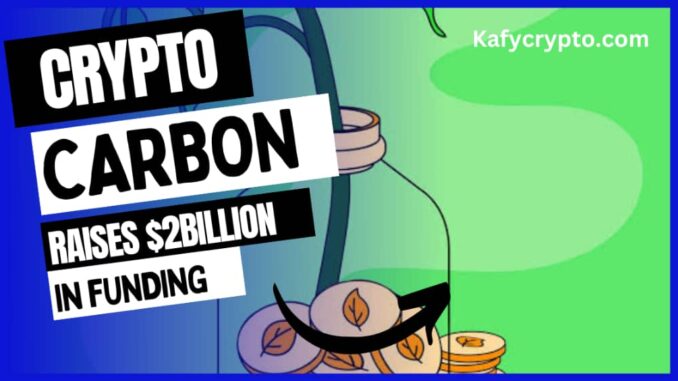
Advertisements
Welcome to Kafycrypto, your number one crypto news, and marketing channel. In todays article, we will be discussing about crypto carbon credits new achievement.
[[ez-toc]
Advertisements
Crypto Carbon Credits raises $2billion in funding from investors to diversify into Internet of Energy
What is Crypto carbon Credits
Crypto carbon credits is a trading company that trades projects which would not have been able to find buyers on the traditional markets. This technology does not address the Paris Agreement’s regulatory requirements and only magnifies existing structural problems in the carbon market.
The trading platform’s partnership is designed to combine digital assets with carbon trading products in order to capitalize on institutional investors’ growing interest in both sectors.
1GCX, a digital assets-focused exchange, and T3 Trading (a proprietary trading firm that invests into the space), have reached a deal to raise $2 billion. They also established a $100 million liquidity pool for carbon credit transactions.
Blockworks exclusively heard from executives of the companies that the move was possible due to the unprecedented fundraise to tokenize carbon credits. These securities, according to their proponents, allow institutional investors (including pension plans and endowments) to make measurable alpha from ESG investment products.
Fractionalized carbon credits are a risky asset class. They can be volatile and detractors still have doubts about their effectiveness in stopping the spread of global heating. The offsets trade more like digital assets than any other, even though they have steeper price swings.
What is 1GCX
1GCX is the provider of the infrastructure necessary for this ambitious new trading platform.
T3 is a global trading platform that moves capital between major crypto exchanges. It also invests in commodity markets. The firms also specialize in equity derivatives, and have developed a variety of synthetic trading pairs that combine commodities with cryptocurrency. The terms of the deal are not known.
It is a plan to create liquidity pools and other market-making activities over-the-counter that will reduce spreads of transactions to attract institutions to the markets. This includes entities from traditional finance who are familiar with carbon assets, but still have a lot to learn about digital assets.
RA Wilson, 1GCX’s chief technology officer, said to Blockworks that the company had been researching the feasibility and cost of quantitatively-driven execution for the initiative for many years. This was particularly driven by the fact that there were not many market makers that could pair digital assets with real-world commodities and derivatives.
Wilson says that liquidity is largely made up of bulge bracket banks buying large quantities of carbon securities at discount prices and acting as an unofficial marker for counterparty trading companies. These trades are almost always OTC and banks will likely get a large spread.
Crypto Carbon Credits Tokenization: The case
Wilson, who has invested in crypto since 2011, stated that he noticed five years ago that carbon credits, which are promoted by governments including the US and offering tax incentives in select cases, were gaining momentum. However, the companies view the products more as a do-good effort than the currency they were intended to be.
Wilson stated that business development begins with creating the right market, providing liquidity and offering nature-based solutions. Globally, it can be beneficial to diversify financial assets from land-based investments.
1GCX is still in the early stages of its blockchain development. It features a token that draws parallels between “proof-of authority” (computational proof) and “computational verification-of authority”.
A method for signing off transactions that uses elements of proof-of stake consensus mechanisms, but relies upon validators who are staking their reputation. This is typically found in private, centralized blockchains rather than public permissionless ones.
The ultimate goal is to create a market for digital assets based on the “green web” and the internet of energy.
This first-of-its kind setup would improve transparency in price discovery and real utility in combating climate change. These are two of the common problems of institutional investors who have to rely on Wall Street or the commodities hub of Chicago to transact carbon credits that are ineligible due to the opaque pricing of market makers.
1GCX traders already have access to many digital assets such as bitcoin, AVAX, SOL, and ether.
Wilson says there is a growing demand from institutions for carbon offset credits. He said that the launch of the trading platform should increase liquidity, transparency, fair pricing, and reduce fraud by adding crypto to it.

Leave a Reply
You must be logged in to post a comment.